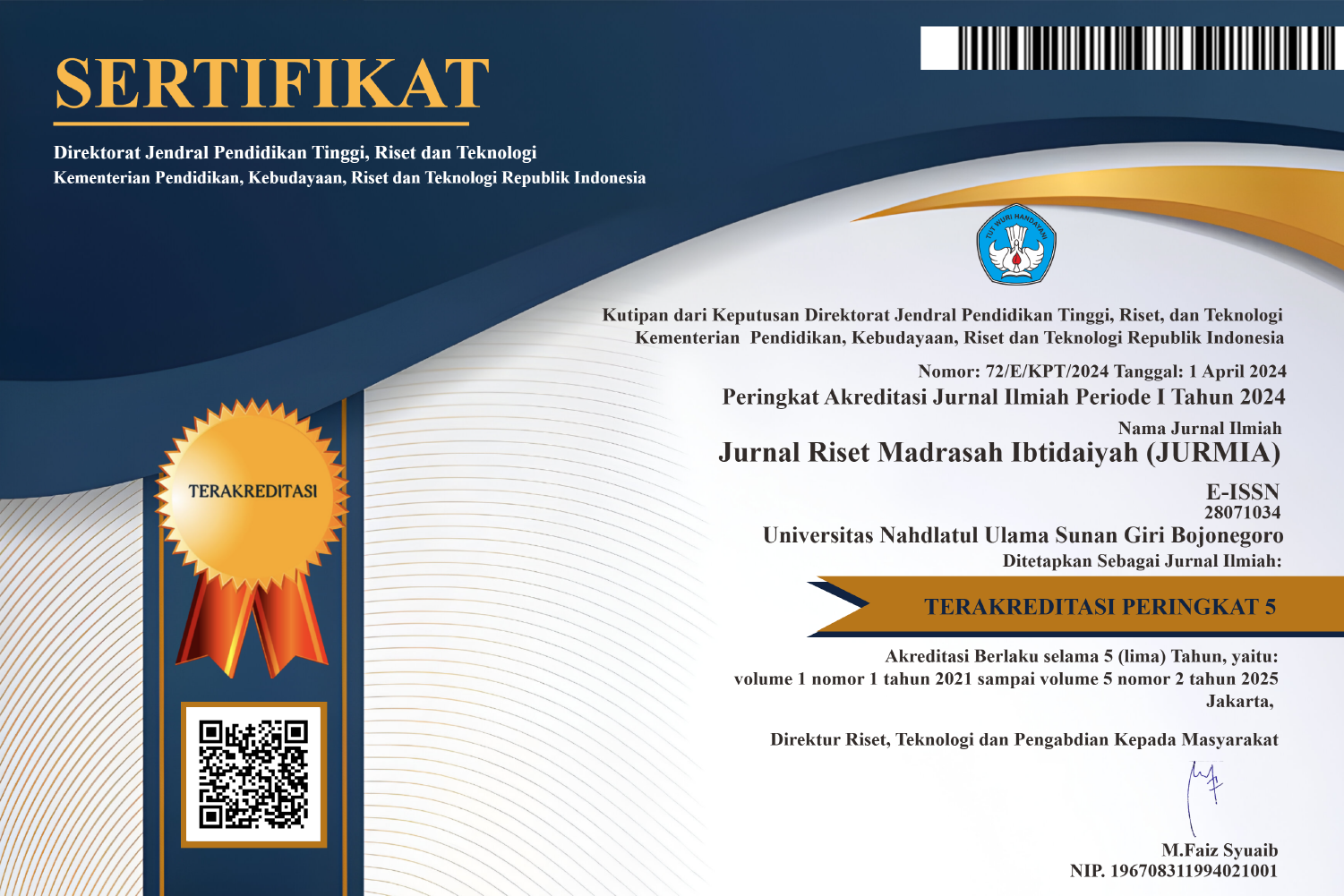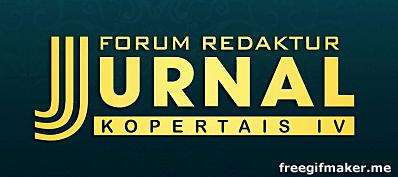Pelaksanaan Program Tahfidz Juz 30 Melalui Metode FALTORCAMA di MI Salafiyah Syafi’iyah Proto 01 Kedungwuni Pekalongan
 PDF Download: 1285
PDF Download: 1285
DOI:
https://doi.org/10.32665/jurmia.v2i2.341Keywords:
Madrasah Iibtidaiyah, FALTORCAMA method, tahfizh programAbstract
The curriculum in the world of education continues to develop. At the Madrasah Ibtidaiyah level, curriculum development is carried out by holding a tahfidz program. MI Salafiyah Syafi'iyah (MISS) Proto 01 has a special method for implementing the tahfizh juz 30 program called the FALTORCAMA method. This study aims to explain the planning, implementation, and methods, as well as the inhibiting and supporting factors in the implementation of the tahfidz Juz 30 program through the FALTORCAMA method at MISS Proto 01 Kedungwuni Pekalongan. The method used in this study is a qualitative method with a descriptive approach, in seeking information about this research, the authors use interviews, observation, and documentation. The result of this research is that the planning of this program is based on efforts to increase students' abilities according to the conditions and potentials in their environment and as a form of the school's contribution to the surrounding community, namely realizing Proto Village as "Kampung Tarbiyatul Qur'an". The implementation and the method used is FALTORCAMA which is memorized, deposited, and read together. The inhibiting factors in this program are the abilities of each child and the limited implementation time. Meanwhile, the supporting factor for this tahfidz program is the good support from all parties and the enthusiasm and high students in memorizing the Qur'an. The tahfidz Juz 30 program can be said to be appropriate to be implemented at MISS Proto 01 Kedungwuni Pekalongan.
References
Anggraini, Dian Mego. (2019). Metode Menghafal Pada Siswa Usia Sekolah Dasar di SDI Al-Munawwarah Pamekasan. FIKROTUNA; Jurnal Pendidikan dan Manajemen Islam. Volume 10 (2). Hlm. 1325.
Anwar, Hafiyana. (2018). Implementasi Metode ODOA (One Day One Ayat) Dalam Meningkatkan Kemampuan Menghafal Al-Qur’an. Jurnal Pendidikan Islam Indoesia. Hlm. 85.
Arifin. (2015). Tahfidzul Qur’an Program at SDIT Fajrul Islam Wiradesa Pekalongan Centre Of Java Indonesia. Jurnal of Social Sciences and Humanities. Hlm. 96.
Fithriyah, D. N., Yulia, N. M., & Aula, F. D. (2022). Dampak Pembelajaran Daring Selama Pandemic Terhadap Kemampuan Kognitif Peserta Didik. Jurnal Riset Madrasah Ibtidaiyah (JURMIA), 2(1), 173-180.
Indriyani. (2016). Pembelajaran Tahfidzul Qur’an Di Sekolah Dasar Islam Terpadu (SDIT) Mutiara Insan Dan Sekolah Dasar Islam Terpadu (SDIT) Fatahillah Sukoharjo Tahun Pelajaran 2016/ 2017. Tesis. Surakarta: Universitas Muhammadiyah Surakarta.
Maimun, L. (2016). Islamic Studies and Character Building. Pekalongan: Penerbit NEM. Hlm. 30.
Minsih, Rusnilawati. (2019). Imam Mujahid, Kepemimpinan Kepala Sekolah dalam Membangun Sekolah Berkualitas di Sekolah Dasar. Surakarta: Universitas Muhammadiyah Surakarta, Vol. 6, No. 1, Hlm. 31.
M. Romadlon Habibullah, Mukholidatul Musthofiah, & Hamidatun Nihayah. (2021). Baca Tulis Al Qur’an dengan Metode Jet Tempur di Madrasah Ibtidaiyah Matholiul Falah Payaman Ngraho Bojonegoro. Jurnal Riset Madrasah Ibtidaiyah (JURMIA), 1(1), 29–39. https://doi.org/10.32665/jurmia.v1i1.193
Muhammad, A. S Oase Al-Qur’an Penyejuk Kehidupan. (2017). Yogyakarta: Qaf Media Kreativa. Hlm. 21.
Muslimin, A. (2015). Implementasi Metode Halaqah dan Resit asi dalam Tahfidz Al-Qur’an di SDIT El- Haq Banjarsari Buduran Sidoarjo. Jurnal Pendidikan Islam. Hlm. 56.
Najib, M. (2018). Implementasi Metode Takrir Dalam Menghafalkan Al Quran Bagi Santri Pondok Pesantren Punggul Nganjuk. Jurnal Intelektual: Jurnal Pendidikan Dan Studi Keislaman, 8(3), Hlm. 334.
Qomariyah, N, Mohammad Irsyad. (2016). Metode Cepat dan Mudah Agar Anak Hafal. Yogyakarta: Semesta Hikmah, Hlm. 48-49.
Redaksi MQ Time. (2020). Majalah Madrasatul Qur an TimesEdisi 7: Covid-19 Refleksi dan Recovery. Tebuireng: Pondok Pesantren Madrasatul Qur an Tebuireng. Hlm. 51-54.
Romadhan, S. (2021). Pengembangan Bahan Ajar Budaya Literasi Melalui Cerita Rakyat dalam Membentuk Sikap Nasionalisme Siswa Sekolah Dasar. Jurnal Riset Madrasah Ibtidaiyah (JURMIA), 1(1), 81-88.
Salamah, U. (2018). Pengajaran Menggunakan Metode Kaisa Dalam Menghafal Al Quran Pada Anak. Journal TA’LIMUNA. 7 (2). Hlm. 125.
Suttrisno, S. (2021). Analisis Dampak Pembelajaran Daring terhadap Motivasi Belajar Siswa Madrasah Ibtidaiyah. Jurnal Riset Madrasah Ibtidaiyah, 1(1), 348380.
Suttrisno, S. (2021). Pengaruh Pemanfaatan Alat Peraga Ips Terhadap Kinerja Guru Sekolah Dasar. Jurnal Ilmiah Pendidikan Dasar, 8(1), 77-90.
Syafi’ie e el- Bantanie, M Abu Fitran. (2015). Tuhan, Tunggu Sebentar Lagi. Jakarta: Wahyu Qolbu. Hlm. 104.
Utami, Maharai. (2018) . Kelebihan dan Kekurangan Metode Talaqqi dalam Program Tahfidz Al- Qur’an Juz 29-30 Pada Siswa kelas Atas Madrasah Ibtidaiyah Muhammadiyah. Jurnal Profesi Pendidikan Dasar. Hlm. 188.
Wijaya, A. (1994). Bimbingan Praktis Menghafal Al-Qur’an. Jakarta: Bumi Aksara Hlm. 61.
Downloads
Published
Issue
Section
License
Copyright (c) 2022 Aan Fadia Annur, Syafa'atul Khusna, Latifah Amalia Fajarsiwi, Abidurrohman

This work is licensed under a Creative Commons Attribution 4.0 International License.
 PDF Download: 1285
PDF Download: 1285










